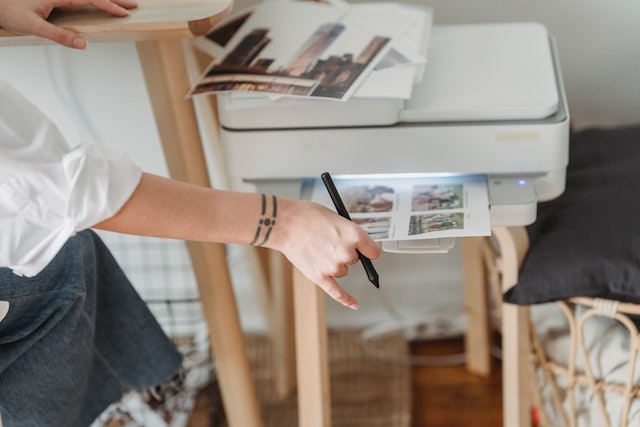Dye sublimation printing is dynamic! You’ve found the proper spot to boost your business’s branding and exposure. Dye sublimation printing can help you stand out in the digital world. Dye sublimation printers—what are they? Its workings? How can companies use this technology? We’ve got the answers. Get ready to learn about dye sublimation printing machines. Jump in!
What’s dye sublimation printing?
The dye sublimation printing equipment lets businesses print colorful, high-quality graphics on fabrics, ceramics, metals, and more. Dye sublimation converts solid dyes into gas using heat and pressure, unlike direct printing. This gas permeates the substrate and bonds with its fibers or coating, creating a photo-realistic image that won’t fade or shatter.
Today’s dye sublimation printers vary. Desktop and large-format printers are the most frequent. It’s important to match your business needs to a type’s features and capabilities. Dye sublimation printers offer gorgeous images with excellent color fidelity. The prints are smooth without dots or lines, making them ideal for banners, flags, garments, and bespoke home decor.
However, examine the negatives. Dye sublimation prints well on polyester or polymer-coated textiles. This printing method takes longer than others because it requires digital design preparation and substrate transfer. Dye sublimation printing equipment is versatile despite these challenges. This adaptable technique can let fashion designers generate distinctive patterns on apparel and photographers create gallery-worthy prints on canvas. Next, I’ll show you how to utilize a dye sublimation printer and give you some advice. Stay tuned!
Dye Sublimation Printer Types
Dye Sublimation Printer Types Different dye sublimation printing machines exist. Before choosing, you should know each type’s pros and cons. Desktop dye-sublimation printers are common. These tiny printers are ideal for small enterprises and individuals. They’re perfect for personalized mugs, phone cases, and t-shirts because they’re easy to use and print well.
Wide-format dye sublimation printers handle large-scale printing. These devices can print enormous projects in spectacular detail. Professional photographers and businesses with enormous banners use them. Roll-to-roll dye sublimation printers are another alternative. This machine prints continuous fabric or paper rolls. It’s ideal for textile makers and fashion designers printing complicated designs on materials.
Consider your needs and budget when choosing a dye sublimation printing machine. Consider print size, production volume, and print quality. Finally, the appropriate dye sublimation printing machine can transform your business. These machines, whether desktop or wide-format, offer adaptability and high-quality results that will impress your customers.
Dye-Sublimation Printer Pros and Cons
Dye sublimation printers provide bright, high-quality prints. Like any technology, they have pros and cons. Explore them below. Dye sublimation printers are great for detail. Heat transfer allows ink to penetrate deep into fabric or substrate, producing sharp and crisp patterns. Businesses that need sophisticated patterns or photos on their products should use it.
Dye sublimation prints are durable. Dye-sub-printed graphics are embedded in the cloth, unlike typical printing processes. They resist fading, cracking, and peeling, making them ideal for products that will be worn and washed. Dye sublimation printers have a wide color spectrum and good color accuracy. They render gradients without banding or pixelation. They are perfect for garment printing, signage, promotional products, interior design, and more.
One drawback is that dye sublimation printers need to transfer paper or film to work. Large print volumes might rack up this extra cost. Dye sublimation printers also cost more upfront. Small firms may not be able to afford this. The procedure is also slower than other printing methods. Each print takes appropriate heat press time and numerous procedures, including transferring ink onto paper and subsequently onto your selected material. Dye-sub prints are durable, but not all fabrics are acceptable. Some materials
What Industries Use Dye Sublimation Printers?
Businesses expanding their product line use dye sublimation printing devices. These printers can print high-quality, bright graphics on many surfaces, making them useful in many sectors. Fashion and apparel benefit from dye sublimation printers. This printing process lets firms make bespoke t-shirts, leggings, and accessories. After numerous washes, the colors and prints remain vibrant.
Promotional products can also use dye sublimation printers. A dye-sublimation printer lets companies print their logo or message on mugs, keychains, and phone cases.
Dye sublimation printing also benefits house decor. This industry may provide customers with unique pillows and wall art prints that bring individuality and charm to any place. Other enterprises, such as sports teams desiring personalized jerseys or photographers printing on canvas, can benefit from dye sublimation printers. Dye sublimation printers can help businesses offer customized items. It permits creativity and personalization with high-quality outcomes that will impress customers.
Dye-Sublimation Printer Use
Dye sublimation printers might be frightening, but with the appropriate knowledge and technique, you can quickly make outstanding commercial prints. Start with these easy steps. Prepare all materials. A good dye sublimation printer, appropriate ink or toner, transfer paper, and the item to print on are needed.
Prepare your design using graphic design software. Make sure it fits your print area and save it in a printer-friendly format. Load the transfer paper into the printer tray according to the manufacturer’s instructions. Adjust any settings such as print quality or color correction as needed.
Once everything is set up correctly, send your design to print! Be patient as this process may take some time depending on the complexity of your design and the size of your print.
After printing is complete, carefully remove the transfer paper from the printer and trim any excess edges if necessary. Place it face down onto the item you wish to sublimate.
Apply heat using a heat press machine or other suitable method according to specific instructions provided by both your transfer paper and the item being printed on. The heat will cause the ink on the transfer paper to turn into gas and penetrate into fibers of the fabric or coat hard surfaces like mugs or phone cases.
Allow sufficient cooling time before handling your newly printed item. Once cooled down completely, you can enjoy its vibrant colors and durability!
Remember that practice makes perfect when it comes to using a dye sublimation printer – don’t be discouraged if your first few attempts aren’t perfect! Experiment with different techniques and materials until you achieve optimal results for your business needs.
Dye Sublimation Printing Recipes
Dye Sublimation Printing Recipes
Now that you know all about dye sublimation printing machines and how to use them, let’s dive into some exciting dye sublimation printing recipes! These recipes will help you unleash your creative side and produce stunning prints for your business.
1. Vibrant Apparel Prints: To create eye-catching apparel prints, start with a high-quality polyester fabric. Make sure the design is vibrant and colorful. Set your heat press to the recommended temperature and time for sublimation printing. Place the fabric on the heat press, position the transfer paper with your design on top, and apply firm pressure. Once done, peel off the transfer paper to reveal a vivid, durable print.
2. Personalized Mugs: Custom mugs are always in demand as they make great gifts or promotional items. For this recipe, choose a ceramic mug specifically made for dye sublimation printing. Print your desired image onto special sublimation paper using compatible inks. Wrap the printed paper tightly around the mug with heat-resistant tape ensuring it aligns perfectly with your design’s placement area. Heat press at the appropriate temperature and time recommended by both your machine and ink manufacturer for ceramic substrates.
3. Unique Phone Cases: Stand out from the crowd by offering personalized phone cases using dye-sub technology! Select blank phone cases suitable for sublimation printing (usually made of polycarbonate). Customize your designs using graphic software like Adobe Photoshop or CorelDRAW®—be as creative as possible! Once ready, print these designs onto dedicated transfer paper following manufacturer guidelines regarding color profiles and printer settings specific to their product line-up.
4. Bold Home Decor Prints: Bring life to homes by offering customized home decor products such as pillows or wall art through dye-sub technology. Print striking images or patterns onto specially coated blanks designed for home decor purposes. Set up calibration properly so colors reproduce accurately. Heat press accordingly based on substrate and manufacturer instructions.
Remember, these are just a few examples of the endless possibilities





